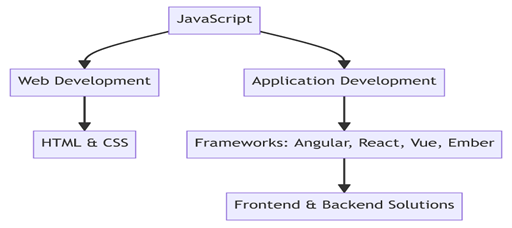Software development stands as the bedrock of the digital era, with numerous professionals dedicating their careers to shaping the next generation of software tools. Within this vast realm of programming languages, JavaScript emerges as a pivotal player, offering multifaceted advantages that have positioned it at the forefront of modern web and application development. In this article, we delve into the core attributes of JavaScript and how it distinguishes itself as an invaluable asset for both budding and seasoned developers.
An Introduction to JavaScript: Beyond Just Web Development
JavaScript, often abbreviated as JS, is a high-level, interpreted scripting language primarily known for its role in web development. However, its capabilities extend far beyond merely enhancing websites. Paired with HTML and CSS, JavaScript forms the triad that crafts interactive, dynamic, and user-friendly web applications. Its ever-growing frameworks and libraries have further solidified its place as the language of choice for many developers.
Key Benefits of Adopting JavaScript in Software Development
1. Simplicity & Accessibility
Contrary to popular belief, diving into JavaScript doesn’t necessitate prior mastery of languages like C++ or Java. Its intuitive syntax and structure make it accessible to beginners, enabling them to start crafting applications after just a few tutorials. This ease of adoption has played a significant role in its widespread popularity.
2. Speed & Efficiency
JavaScript stands out for its client-side execution, allowing code to run on the user’s machine rather than on a remote server. This minimizes data transmission between the server and the browser, resulting in faster load times and smoother user experiences. For developers, this translates to quicker feedback loops and more efficient development cycles.
3. Rich Framework Ecosystem
The JavaScript ecosystem is replete with powerful frameworks that streamline the development process. These tools, ranging from Angular and React to Vue and Ember, offer pre-built functionalities and structures, enabling developers to focus on creating unique features rather than reinventing the wheel.
Cost-Effectiveness:
Many of these frameworks are open-source, reducing the overhead costs associated with software development.
Rapid Development:
A vast array of resources, including documentation and community support, accelerates the development process.
Enhanced Efficiency: Pre-defined templates and functions in these frameworks allow developers to execute projects swiftly with reduced code.
4. Versatility & Compatibility
JavaScript’s adaptability is one of its standout features. It seamlessly integrates with various servers and can be embedded in any webpage irrespective of the file extension. Furthermore, its compatibility across devices and browsers ensures that applications remain consistent in diverse environments.
5. Thriving Community & Resource Pool
Being open-source, JavaScript enjoys the support of a vast and active community. This collective effort ensures continuous improvements, bug fixes, and the addition of new features. Libraries such as Bootstrap simplify the integration of UI components, and the expansive community support ensures developers never feel isolated.
Leading JavaScript Frameworks for Cutting-Edge Software Development
Frameworks bolster the capabilities of JavaScript, aiding developers in creating both frontend and backend solutions with ease.
- Angular.js: Tailored for single-page applications, Angular facilitates the creation of interactive sites with features like posts, comments, and likes.
- React.Js: A product of open-source collaboration, React focuses on building efficient and dynamic user interfaces.
- Vue.js: Vue is a favorite for simpler projects, offering advantages like user-friendliness, easy customization, and comprehensive documentation.
- Ember: Designed for ambitious web applications, Ember equips developers with tools for creating rich user interfaces.
Crafting a Career as a JavaScript Developer
In today’s tech-centric landscape, where giants like Facebook and Google dominate, the demand for proficient JavaScript developers is surging. If you’re setting sights on this rewarding career, here’s a roadmap:
- Grasp Programming Fundamentals: Understand core concepts such as object-oriented programming, loops, and the Document Object Model (DOM).
- Engage in Hands-on Projects: Practical implementation is key. Work on minor projects or internships to hone your skills.
- Seek Professional Courses: Acquiring a certification boosts your credibility and opens doors to lucrative opportunities.
- Consistent Practice: Regular coding exercises refine your skills, preparing you for complex challenges ahead.
- Deep Dive into JavaScript Frameworks: Familiarize yourself with popular frameworks to stay ahead of the curve.
- Sharpen Your Algorithmic Skills: Master foundational algorithms to tackle intricate programming challenges efficiently.
- Explore Job Opportunities: Platforms like Indeed, JavaScript Works, and Monster are treasure troves for aspiring developers.
Diagram Showing JavaScript’s multifaceted roles in both web and application development.

Advanced Features & Future Prospects of JavaScript
As technology evolves, so does the repertoire of JavaScript, making it an evergreen asset in the developer’s toolbox. Here, we delve deeper into some of the advanced features that set JavaScript apart and glimpse into its promising future.
- Interoperability with Other Technologies
JavaScript’s design inherently allows for seamless integration with other programming languages and technologies. This means developers can embed JavaScript within other codes or call upon other languages within a JavaScript environment. Such interoperability is pivotal in today’s diverse tech landscape, ensuring that systems communicate effectively and function harmoniously.
- Real-time Capabilities with WebSockets
JavaScript’s real-time capabilities, especially when combined with WebSockets, enable developers to build applications that can instantly push data to users. This is vital for applications like live sports scores, stock trading platforms, and chat applications, where real-time data updates are crucial.
- Server-Side Development with Node.js
Node.js has revolutionized how developers perceive JavaScript. No longer confined to just client-side scripting, with Node.js, developers can now use JavaScript for server-side development. This means they can build scalable network applications that can handle a large number of simultaneous connections with high throughput.
- Mobile App Development Capabilities
With frameworks like React Native and Ionic, JavaScript extends its reach into the realm of mobile app development. These frameworks allow for the development of native-like applications using a single codebase, streamlining the process and ensuring consistency across platforms.
- Machine Learning and Artificial Intelligence
The future of technology is inextricably linked with AI and machine learning, and JavaScript is no exception. Libraries like TensorFlow.js bring machine learning capabilities directly to JavaScript, allowing developers to harness the power of AI in their applications.
- Progressive Web Apps (PWAs)
PWAs are web applications that offer a native app-like experience on the web. JavaScript, along with service workers, empowers developers to create these immersive, high-performance web applications that can work offline, send push notifications, and access device hardware, just like native apps. This convergence of web and mobile provides users with a seamless experience irrespective of their device or connectivity.
- WebAssembly (Wasm)
WebAssembly is a binary instruction format that enables high-performance execution of code on web browsers. While not a replacement for JavaScript, it complements it. With JavaScript and WebAssembly working in tandem, developers can run code written in languages like C and C++ in the browser, pushing the boundaries of web performance and capabilities.
- Serverless Architectures & Cloud Integration
With the advent of cloud technologies, serverless architectures are gaining traction. JavaScript, especially with platforms like Node.js, is at the heart of this paradigm shift. Serverless frameworks allow developers to build applications without worrying about server provisioning or maintenance. This model enhances scalability, reduces costs, and accelerates deployment.
- Augmented Reality (AR) & Virtual Reality (VR) on the Web
The integration of AR and VR into web applications is becoming more feasible, thanks to JavaScript. Libraries such as A-Frame and Three.js facilitate the creation of 3D and VR experiences directly in the browser. As AR and VR technologies mature, JavaScript’s role in crafting immersive web experiences will become even more pivotal.
- API-first Development
The modular nature of modern applications necessitates an API-first approach. JavaScript, particularly with its rich ecosystem of RESTful services and GraphQL implementations, is crucial for developing robust APIs that ensure seamless data flow between frontend and backend components.
Sustainability and Longevity of JavaScript
The constant influx of new technologies and paradigms might lead one to question the longevity of any programming language. However, JavaScript’s adaptability and its continuous evolution, coupled with a vast and active community, ensure its relevance for years to come.
JavaScript’s open-source nature means that it benefits from the collective intelligence of thousands of developers worldwide. This collaborative spirit guarantees that the language stays updated, with regular enhancements, new features, and timely security patches.
JavaScript’s Integration with IoT (Internet of Things)
One of the most exciting technological revolutions of the 21st century is the proliferation of the Internet of Things (IoT). With billions of devices interconnected, the IoT ecosystem requires robust and scalable software solutions, and JavaScript emerges as a key player in this domain.
Real-time Data Handling
IoT devices constantly generate vast amounts of data that need to be processed in real-time. JavaScript, with its asynchronous capabilities and event-driven architecture, is well-suited to manage and process this data effectively. Libraries such as Socket.io enable real-time bidirectional event-based communication, ensuring timely data relay between devices and servers.
Cross-Platform Development
IoT devices come in various forms and operating systems, from smart thermostats to wearable health devices. JavaScript, with its cross-platform nature, allows developers to write a single codebase that can run across multiple devices, ensuring consistency and reducing development time.
Microservices and Decentralized Architectures
The decentralized nature of IoT requires architectures that can operate independently and scale as needed. JavaScript, particularly with Node.js, supports the development of microservices – small, independent modules that can function autonomously. This ensures that if one service fails, it doesn’t bring down the entire system, a critical feature for the vast IoT networks.
Integration with Cloud Services
Many IoT solutions rely on cloud platforms for data storage, analysis, and management. JavaScript interfaces seamlessly with popular cloud providers, facilitating easy data transfer, storage, and retrieval. This integration simplifies the development process, allowing for efficient data handling and analytics.
Enhanced Security Protocols
As IoT devices often deal with sensitive data, security is paramount. JavaScript offers a suite of security libraries and frameworks that help developers implement encryption, authentication, and other security protocols, ensuring that data remains protected against potential breaches.
The Broader Impact of JavaScript in the Technological Landscape
Beyond its technical capabilities, JavaScript’s influence extends to shaping the very fabric of the digital world. Its community-driven approach ensures that it remains agile, adapting to the ever-evolving needs of the industry.
Education and knowledge-sharing platforms, powered by JavaScript, have democratized learning, enabling individuals worldwide to acquire skills and contribute to the global tech ecosystem. Additionally, its open-source nature fosters collaboration, ensuring continuous innovation and the sharing of best practices.
Conclusion
JavaScript started as a simple tool to make websites more interactive. Today, it has grown a lot and is used in many areas of technology. It helps make websites lively, supports real-time features of devices connected to the internet, and plays a role in creating virtual and augmented reality experiences. As technology continues to advance, JavaScript’s flexibility means it will keep being important, leading the way and setting high standards.
Software Solutions Await – Visit this list of elite Software Developers now.
Table of Contents
Toggle






